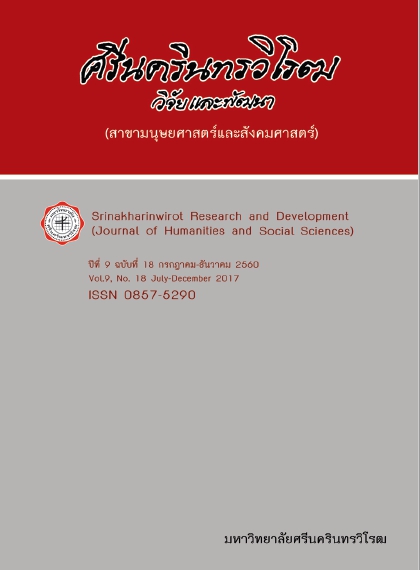พฤติกรรมการบริโภคอาหาร และการใช้น้ำมันทอดอาหาร : กรณีศึกษา อำเภอเกาะสีชัง จังหวัดชลบุรี (FOOD CONSUMPTION AND THE USE OF COOKING OIL FOR DEEP FRYING : A CASE STUDY OF SI-CHANG ISLAND, CHONBURI PROVINCE)
Abstract
การวิจัยครั้งนี้มีวัตถุประสงค์เพื่อสำรวจสถานการณ์ และพฤติกรรมการใช้น้ำมันทอดซ้ำของผู้ประกอบการ จำนวน 49 ร้านค้า และผู้บริโภคทั้งที่เป็นประชาชนทั่วไปและนักท่องเที่ยวในพื้นที่เกาะสีชัง จำนวน 176 คน และ 49 คน ตามลำดับ เก็บรวบรวมข้อมูลด้วยการใช้แบบสำรวจ สัมภาษณ์และสนทนากลุ่ม
ผลการศึกษาพบว่า ผู้บริโภคในเกาะสีชังทั้งประชาชนทั่วไปและนักท่องเที่ยวนิยมซื้ออาหารทอดมารับประทาน ร้อยละ 29.05 และ ร้อยละ 20.54 ตามลำดับ ในขณะที่ผู้ประกอบการอาหารทอดในเกาะสีชัง ระบุว่าตนเองมีการเปลี่ยนน้ำมันทอดอาหารใหม่ทุกครั้งคิดเป็นร้อยละ 22.58 ในขณะที่ผู้ประกอบการที่เหลือ ระบุว่าตนเองใช้น้ำมันทอดอาหารซ้ำโดยมีรูปแบบการใช้น้ำมันซ้ำที่แตกต่างกันออกไป ได้แก่ การใช้ซ้ำ 1-3 ครั้ง โดยไม่เติมน้ำมันใหม่ลงไปผสม (ร้อยละ 35.48) การใช้ซ้ำโดยเติมน้ำมันใหม่เข้าไปทุกครั้ง หรือเติมเมื่อไม่พอทอด (ร้อยละ 22.58) การใช้ซ้ำโดยเติมน้ำมันใหม่สำหรับการทอด 1-3 ครั้ง (ร้อยละ 14.52) และเติมน้ำมันใหม่จนพบว่าน้ำมันมีสีคล้ำ มีควัน หรืออาหารทอดมีกลิ่นผิดปกติ (ร้อยละ 4.84)
นอกจากนี้เมื่อไม่ใช้น้ำมันทอดแล้ว ประชาชนในเกาะที่ประกอบอาหารเองในครัวเรือนส่วนใหญ่ทิ้งน้ำมันในภาชนะปิดสนิทและทิ้งลงถังขยะ (ร้อยละ 28.98) ในขณะที่ผู้ประกอบการ ส่วนใหญ่ (ร้อยละ 46.43) นำน้ำมันที่ใช้แล้วไปจำหน่ายต่อให้กับคนที่มารับซื้อในราคาปี๊บละ 100-400 บาท และผู้ประกอบการบางส่วน ยังคงทิ้งน้ำมันไม่ถูกต้อง เช่น เททิ้งลงท่อระบายน้ำ พื้นดิน ลงทะเล โพลงหิน ทิ้งรวมกับเศษอาหาร หรือนำไปปรุงอาหารหรือประกอบอาหารต่อที่บ้าน ปริมาณการทิ้งน้ำมันและการขายน้ำมันทอดอาหารเฉลี่ยร้านค้าละ 18.83 และ 23.57 ลิตรต่อเดือน
ผลของการทดสอบน้ำมันด้วยชุดทดสอบสารโพลาร์ในน้ำมันทอดซ้ำในเกาะสีชัง พบว่า คุณภาพน้ำมันของร้านค้าในวันหยุดปกติ มีน้ำมันใกล้เสื่อมสภาพและเสื่อมสภาพ ในขณะที่การทดสอบในช่วงวันหยุดต่อเนื่องกลับพบว่า มีน้ำมันใกล้เสื่อมสภาพและเสื่อมสภาพแล้วเพิ่มมากขึ้น
ความเสื่อมสภาพของน้ำมันทอดในพื้นที่เกาะสีชังดังกล่าวส่งผลให้เกิดความเสี่ยงด้านสุขภาพต่อ ประชาชน ในพื้นที่เกาะและพื้นที่ภายนอก จึงควรหาแนวทางให้ความรู้กับประชาชนและผู้ประกอบการในการใช้น้ำมันและกำจัดน้ำมันเสื่อมสภาพอย่างเหมาะสมในอนาคต
The present study aims to survey the situation and the behavior on using cooking oil for deep-fried food sellers and consumers (local consumers and visitors) on Si-Chang Island. The data were collected via questionnaire, interviews and group discussions.
It was found that the local consumers and visitors to Si-Chang Island like to buy deep-fried food at 29.05 % and 20.54 % respectively. The 22.58 % of the sellers reported that they changed the cooking oil every time. The rest of the sellers reported that they reused the oil and used them in different methods such as: using the oil 1-3 times without adding new oil (35.48 %), using and adding new oil every time or when there was not enough oil to cook (22.58 %), using and adding new oil every 1-3 times (14.52 %) and adding new oil only when the oil became dark, began smoking or gave the food a strange smell (4.84 %).
To dispose of the used oil, most people on the island who fried food themselves disposed of the oil in the sealed containers or a trash bin (28.98 %). Meanwhile, most sellers (46.43 %) sold the used oil to vendors for 100-140 baht per bucket. Some sellers also improperly disposed of the oil such as pouring it into the sewer, on the ground, into the sea together with leftover food or reused the oil to cook at home. The average amount of oil disposed of per shop was 18.83 liters per month, and the average amount of used oil sold per shop was 23.57 liter per month.
Testing of reused oil for polar compounds found the quality of the oil used in shops during regular weekends to be nearly deteriorated and already deteriorated. Results from holiday weekends found nearly deteriorated and already deteriorated oil.
The reuse of deteriorated cooking oil on Si-Chang Island could pose health risks to both people on the island and visitors; therefore, education should be provided to both local consumers and sellers regarding the appropriate use and disposal of cooking oil.
Downloads
References
ประชากรไทย พ.ศ. 2556. สืบค้นเมื่อ 14 ธันวาคม 2557, จาก http://www.service.nso.go.th/nso/
nsopublish/service/survey/healthCare_56.pdf
[2] สถาบันวิจัยสังคม จุฬาลงกรณ์มหาวิทยาลัย. (2553). รายงานการสำรวจสถานการณ์ และพฤติกรรม
การใช้น้ำมันทอดซ้ำในประเทศไทย. กรุงเทพฯ: แผนงานคุ้มครองผู้บริโภคด้านสุขภาพ
และสำนักงานกองทุนสนับสนุนการสร้างเสริมสุขภาพ.
Downloads
Published
How to Cite
Issue
Section
License
Srinakharinwirot Research and Development Journal of Humanities and Social Sciences is licensed Under a Creative Commons Attribution-NonCommercial-NoDerivs 4.0 International (CC-BY-NC-ND 4.0) License, Unless Otherwise Stated. Please Read Journal Policies Page for More Information on Open Access, Copyright and Permissions.


